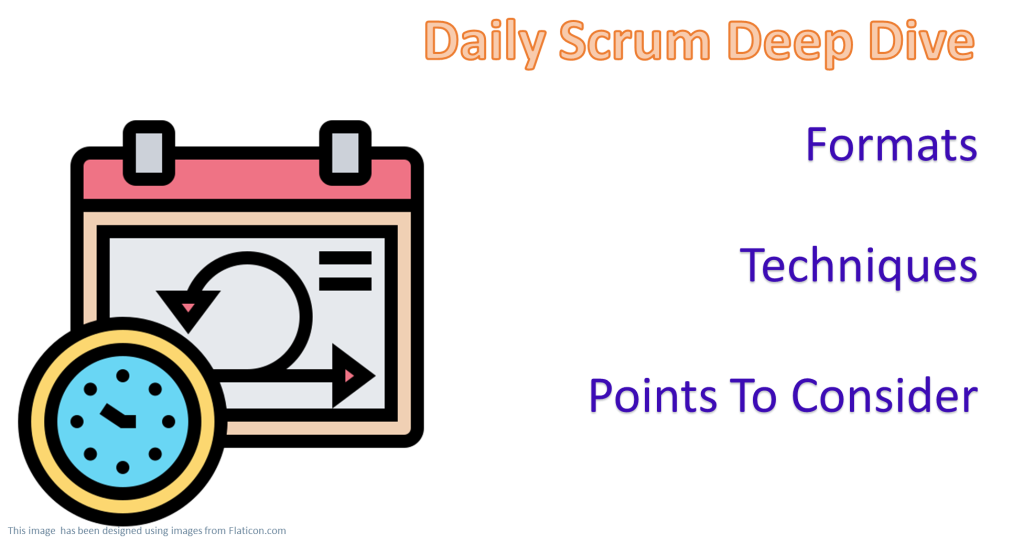Daily Scrum Formats and Techniques

I will discuss Daily Scrum Formats and Techniques in this article. In order to understand the Daily Scrum Event, please read the linked article. Further more, read this article to understand real life scenarios about Daily Scrum
Daily Scrum Formats
Three question format is the most common Format used for daily Scrum. So much so that people often think that its the only possible or Mandatory format for the Daily Scrum. But that’s not the case. In fact, Scrum Guide says that Developers are the people who should choose the format.
Traditional Three Question Format:
This is the most common format for Daily Scrum. When running the format in this format, each developer will answer the below three questions
- What did I do yesterday to meet the Sprint Goal?
- What will I do today to meet the Sprint Goal?
- What impediments are blocking my progress to meet the Sprint Goal?
Simple and Structured nature for this format allows makes it easy to run the Daily Scrum, especially with new Scrum Teams. The major disadvantage are as below
- Teams often lose the focus on Sprint Goal. Instead they ignore the part in bold and convert this discussion into a Status Call.
- Since the teams are discussing work done by individual Developer – its easy for some items to “fall through crack”
Walk the “Scrum Board” Format:
This format is very close to previous “Three Questions” format. Just that we ask the same three questions to individual items (or User Stories) on the Scrum Board. For example, the team together will discuss what work was done on item (or user story )XYZ to meet our Sprint Goal. – Some teams refer to this activity as “walking through” the items on the Scrum Board/ Hence the name of the format.
Some advantages are
- Visual Nature of Board makes it easy to track progress and identify bottle necks
- Since the Scrum Team discusses each story, things do not fall through cracks
Focus on the Sprint Goal Format/ Identify Impediments format:
If all Developers have to answer 3 questions, often 15 minutes are not enough. This is one of major reasons for timebox overrun. In this format we avoid this overrun by having the Developers update their daily status 45 Minutes before the Daily Scrum – Then the team will have more time to quickly identify key impediments that are blocking the progress towards Sprint Goal.
Some Techniques to Consider For Daily Scrum
Gamification
Gamification adds a fun element. It will help to increase the Team member engagement as well as foster lighthearted communication. Some techniques to consider can be
- Achievement Board – Create a Snakes and ladder type game to give points to enabling other people and reduce points when others are waiting for you. This will subtly encourage everyone to collaborates
- Using a randomizer to choose the next speaker – Using a random member to search out next speaker will keep every one on their toes! Their attention will not wander:) Some Teams use a variation of this, where current speaker nominates the next speaker
- Flexible Timebox – A timer will automatically choose a random allowed timebox (within a range) for each speaker – This will help the Developers to get into habit of putting their point across in a concise manner
Rotating Leadership
Daily Scrum is by and for Developers to track their progress towards Sprint Goal. As such, this is an ideal time to mentor Developers to polish their leadership skills. Having the Developers facilitate the session in a rotating manner will help each developer to have their moment to shine. To make it further fun, we can use a randomizer to select the next person to facilitate the Daily Scrum. We can even have the team vote on most fun and most effective Facilitator!
Asynchronized Updates Before the Daily Scrum
If each person has to discuss the status, it takes a lot of time. Instead its better to have a working agreement that each developer will update their status at a common place. This way, everybody can be aware of status as it stands. The discussion then can focus on impediments that can hinder the Scrum Team from reaching the Sprint Goal.
Meeting After
The “Meeting After” is an informal, optional gathering that can follow a Daily Scrum. It’s a space for more in-depth discussions, problem-solving, and collaboration. It creates a space for individual discussions. As a result, this space helps the Scrum Team can avoid discussions that do not need entire Scrum Team during actual daily Scrum
Some General Good Practices for Daily Scrum
Keep Focus
Focus the Daily Scrum Discussions on tracking the Progress towards Sprint goal and then adapt the Sprint Backlog as needed. Please take care not to turn it into a problem-solving or status-reporting session.
Use of Timer
Using a timer provides an external stimulus. This helps the Scrum team to focus.
Practice Inclusivity
Everyone should contribute and feel heard.
Be ready to evolve the format as needed
The format of the Daily Scrum should evolve over time.